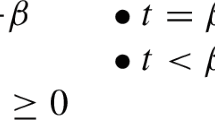Abstract
This article studies situations in which information is ambiguous and only part of it can be probabilized. It is shown that the information can be modeled through belief functions if and only if the nonprobabilizable information is subject to the principles of complete ignorance. Next the representability of decisions by belief functions on outcomes is justified by means of a neutrality axiom. The natural weakening of Savage's sure-thing principle to unambiguous events is examined and its implications for decision making are identified.
Similar content being viewed by others
References
Arrow, K.J., and L. Hurwicz. (1972). “An Optimality Criterion for Decision Making under Ignorance,” In C.F. Carter and J.L. Ford,Uncertainty and Expectations in Economics. Oxford: Basil Blackwell and Mott Ltd.
Cohen, M., and J.Y. Jaffray. (1980). “Rational Behavior under Complete Ignorance,”Econometrica 48, 1281–1299.
Cohen, M., and J.Y. Jaffray. (1983). “Approximations of Rational Criteria under Complete Ignorance,”Theory and Decision 15, 121–150.
Cohen, M., and J.Y. Jaffray. (1988). “Is Savage's Independence Axiom a Universal Rationality Principle?”,Behavioral Science 33, 38–47.
de Finetti, B. (1937). “La Prévision: Ses Lois Logiques, ses Sources Subjectives,”Annales de l'Institut Henri Poincaré 7, 1–68. Translated into English by H.E. Kyburg as “Foresight: Its logical Laws, its Subjective Sources.” In H.E. Kyburg and H.E. Smokier (eds.),Studies in Subjective Probability (1964). New York: Wiley, pp. 53–118; 2nd ed. (1980). New York: Krieger.
Dempster, A.P. (1967). “Upper and Lower Probabilities Induced by a Multivalued Mapping,”Annals of Mathematical Statistics 38, 325–339.
Ellsberg, D. (1961). “Risk, Ambiguity and the Savage Axioms,”Quarterly Journal of Economics 75, 643–669.
Gilboa, I., and D. Schmeidler. (1992). “Additive Representations of Non-Additive Measures and the Choquet Integral,” mimeo.
Halpern, J.Y., and R. Fagin. (1992). “Two Views of Belief: Belief as Generalized Probability and Belief as Evidence,”Artificial Intelligence 54, 275–317.
Herstein, I.N., and J. Milnor. (1953). “An Axiomatic Approach to Measurable Utility,”Econometrica 21, 291–297.
Huber, P.J. (1981).Robust Statistics. New York: Wiley.
Jaffray, J.Y. (1989). “Linear Utility Theory for Belief Functions,”Operations Research Letters 8, 107–112.
Jaffray, J.Y. (1992). “Linear Utility Theory for Belief Functions: A Discussion.” In Proceedings of FUR-IV Conference, Budapest (1988). Dordrecht: Kluwer Academic Publishers.
Jaynes, E.T. (1968). “Prior Probability,”IEEE Transactions on System Sciences and Cybernetics 4, 227–241.
Laplace, P.S. de. (1825).Essai Philosophique sur les Probabilités, 5th ed. Paris. (Originally published in 1814). Translated into English asA Philosophical Essay on Probabilities (1951). New York: Dover.
Pearl, J. (1988).Probabilistic Reasoning in Intelligent Systems: Networks of Plausible Inference. San Mateo, CA: Morgan Kaufmann.
Ramsey, F.P. (1931). “Truth and Probability.” InThe foundations of Mathematics and other Logical Essays. London: Routledge and Kegan Paul, pp. 156–198. Reprinted in H.E. Kyburg and H.E. Smokier (eds.),Studies in Subjective Probability (1964). New York: Wiley, pp. 61–92.
Rota, G.C. (1964). “Theory of Möbius Functions,”Zeitschrift für Warscheinlichkeitstheorie und Verwandte Gebiete 2, 340–368.
Ruspini, E.H. (1987). “The Logical Foundations of Evidential Reasoning.” Revised as Technical Note 408, SRI International, Menlo Park, CA.
Savage, L.J. (1954).The Foundations of Statistics. New York: Wiley; 2nd ed. (1972). New York: Dover.
Schmeidler, D. (1989). “Subjective Probability and Expected Utility without Additivity,”Econometrica 57, 571–587.
Shafer, G. (1976).A Mathematical Theory of Evidence. Princeton, NJ: Princeton University Press.
Shafer, G. (1990). “Perspectives on the Theory and Practice of Belief Functions,”International Journal of Approximate Reasoning 4, 323–362.
Shafer, G., and A. Tversky. (1985). “Languages and Designs for Probability Judgment,”Cognitive Science 9, 309–339.
von Neumann, J., and O. Morgenstern. (1944, 1947, 1953).Theory of Games and Economic Behavior. Princeton, NJ: Princeton University Press.
Zadeh, L.A. (1978). “Fuzzy Sets as a Basis for a Theory of Possibility,”Fuzzy Sets and Systems 1, 3–28.
Author information
Authors and Affiliations
Additional information
The research of Peter Wakker has been made possible by a fellowship of the Royal Netherlands Academy of Arts and Sciences.
Rights and permissions
About this article
Cite this article
Jaffray, J.Y., Wakker, P. Decision making with belief functions: Compatibility and incompatibility with the sure-thing principle. J Risk Uncertainty 7, 255–271 (1993). https://doi.org/10.1007/BF01079626
Issue Date:
DOI: https://doi.org/10.1007/BF01079626




